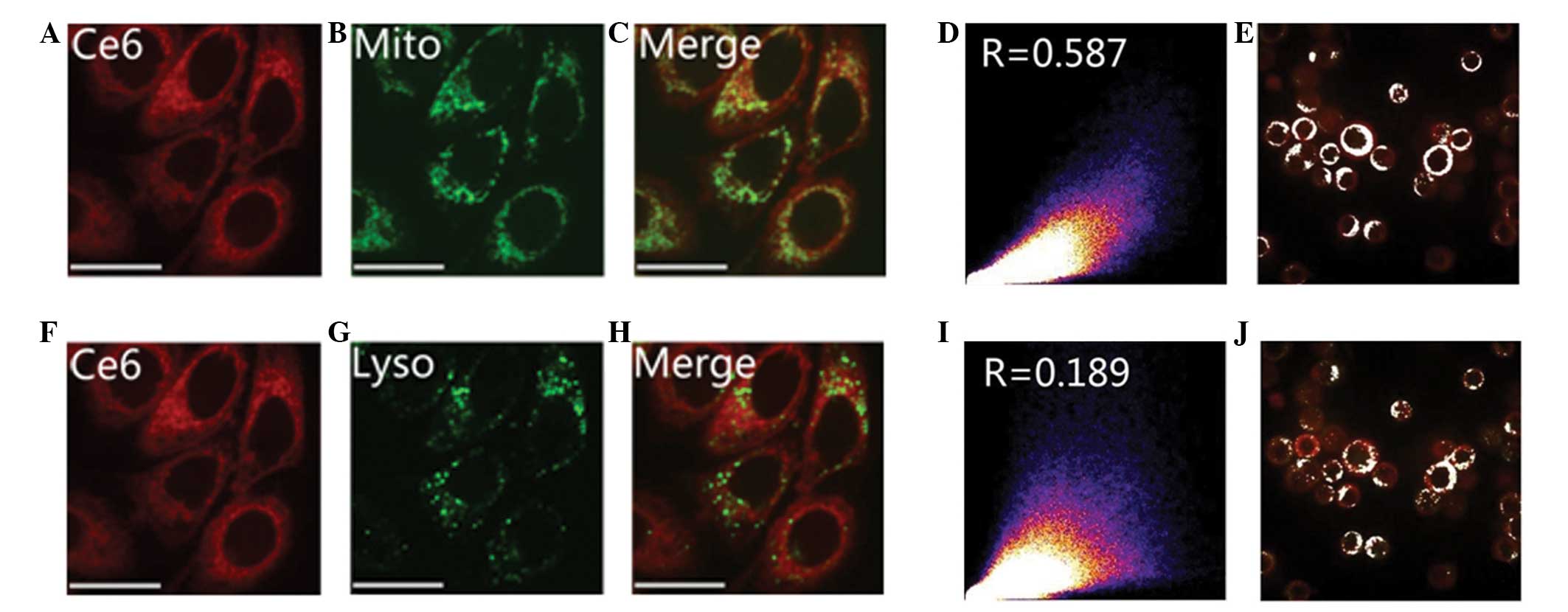
Subcellular location and photodynamic therapeutic effect of chlorin e6 in the human tongue squamous cell cancer Tca8113 cell line
- Authors:
- Wei Luo
- Rong-Sen Liu
- Jian-Guo Zhu
- Ying-Chao Li
- Hong-Chen Liu
-
View Affiliations
Affiliations: Institute and Department of Stomatology, Chinese People's Liberation Army General Hospital, Beijing 100853, P.R. China, Department of Laser Medicine, Chinese People's Liberation Army General Hospital, Beijing 100853, P.R. China
- Published online on: November 20, 2014 https://doi.org/10.3892/ol.2014.2720
-
Pages:
551-556
-
Copyright: © Luo
et al. This
is an open access article distributed under the
terms of Creative
Commons Attribution License.
Metrics:
Total
Views: 0 (Spandidos Publications: | PMC Statistics:
)
Metrics:
Total PDF Downloads: 0 (Spandidos Publications: | PMC Statistics:
)
This article is mentioned in:
Abstract
The present study aimed to investigate the distribution and photodynamic therapeutic effect of chlorin e6 (Ce6) in the human tongue squamous cell carcinoma Tca8113 cell line in vitro. The distribution of Ce6 in the Tca8113 cells was observed in situ combined with mitochondrial and lysosomal fluorescent probes. Next, 630‑nm semiconductor laser irradiation was performed. The MTS colorimetric method was used to determine cell survival. Annexin V fluorescein isothiocyanate/propidium iodide (PI) double staining was used to detect early apoptosis following photodynamic therapy (PDT). The flow cytometer was used to analyze the DNA content subsequent to PI‑staining. It was observed that Ce6 could combine with the cellular membrane following 30 min of incubation with the Tca8113 cells. As the length of incubation increased, Ce6 gradually entered the cells in a particular distribution and reached saturation by 3 h. Co‑localization analysis demonstrated that Ce6 was more likely to be present in the mitochondria than in the lysosomes. The cells incubated with 5 µg/ml Ce6 for 24 h exhibited a low toxicity of 5%, however, following light irradiation, Ce6‑PDT was able to kill the Tca8113 cells in vitro. The cell toxicity was positively correlated with Ce6 concentration and light dose, therefore, the effect of Ce6 was concentration/dose‑dependent (P<0.01). The lower Ce6 concentrations and light doses could significantly induce apoptosis in the Tca8113 cells, while higher doses increased necrosis/percentage of dead cells. In summary, Ce6 saturated the Tca8113 cells following 3 h of incubation. Furthermore, Ce6‑PDT effectively killed the cultured Tca8113 cells in vitro at a safe concentration. At a low concentration and light dose, Ce6 is more likely to induce cell apoptosis via the mitochondria than the lysosomes.
View References
|
1
|
Warnakulasuriya S: Global epidemiology of
oral and oropharyngeal cancer. Oral Oncol. 45:309–316. 2009.
View Article : Google Scholar
|
|
2
|
Gibson MK and Forastiere AA:
Multidisciplinary approaches in the management of advanced head and
neck tumors: state of the art. Curr Opin Oncol. 16:220–224. 2004.
View Article : Google Scholar : PubMed/NCBI
|
|
3
|
Neville BW and Day TA: Oral cancer and
precancerous lesions. CA Cancer J Clin. 52:195–215. 2002.
View Article : Google Scholar : PubMed/NCBI
|
|
4
|
Biel MA: Photodynamic therapy treatment of
early oral and laryngeal cancers. Photochem Photobiol.
83:1063–1068. 2007. View Article : Google Scholar : PubMed/NCBI
|
|
5
|
Fien SM and Oseroff AR: Photodynamic
therapy for non-melanoma skin cancer. J Natl Compr Canc Netw.
5:531–540. 2007.PubMed/NCBI
|
|
6
|
Taub AF: Photodynamic therapy: other uses.
Dermatol Clin. 25:101–109. 2007. View Article : Google Scholar
|
|
7
|
Woodburn KW, Fan Q, Kessel D, et al:
Photodynamic therapy of B16F10 murine melanoma with lutetium
texaphyrin. J Invest Dermatol. 110:746–751. 1998. View Article : Google Scholar : PubMed/NCBI
|
|
8
|
Malik R, Manocha A and Suresh DK:
Photodynamic therapy - a strategic review. Indian J Dent Res.
21:285–291. 2010. View Article : Google Scholar : PubMed/NCBI
|
|
9
|
Luketich JD, Christie NA, Buenaventura PO,
et al: Endoscopic photodynamic therapy for obstructing esophageal
cancer: 77 cases over a 2-year period. Surg Endosc. 14:653–657.
2000. View Article : Google Scholar : PubMed/NCBI
|
|
10
|
Walther MM: The role of photodynamic
therapy in the treatment of recurrent superficial bladder cancer.
Urol Clin North Am. 27:163–170. 2000. View Article : Google Scholar : PubMed/NCBI
|
|
11
|
Buytaert E, Dewaele M and Agostinis P:
Molecular effectors of multiple cell death pathways initiated by
photodynamic therapy. Biochim Biophys Acta. 1776:86–107.
2007.PubMed/NCBI
|
|
12
|
Kostenich GA, Zhuravkin IN, Furmanchuk AV
and Zhavrid EA: Photodynamic therapy with chlorin e6. A morphologic
study of tumor damage efficiency in experiment. J Photochem
Photobiol B. 11:307–318. 1991. View Article : Google Scholar : PubMed/NCBI
|
|
13
|
Gijsens A, Missiaen L, Merlevede W and de
Witte P: Epidermal growth factor-mediated targeting of chlorin e6
selectively potentiates its photodynamic activity. Cancer Res.
60:2197–2202. 2000.PubMed/NCBI
|
|
14
|
Luo Y and Kessel D: Initiation of
apoptosis versus necrosis by photodynamic therapy with
chloroaluminum phthalocyanine. Photochem Photobiol. 66:479–483.
1997. View Article : Google Scholar : PubMed/NCBI
|
|
15
|
Sheleg SV, Zhavrid EA, Khodina TV, et al:
Photodynamic therapy with chlorin e(6) for skin metastases of
melanoma. Photodermatol Photoimmunol Photomed. 20:21–26. 2004.
View Article : Google Scholar : PubMed/NCBI
|
|
16
|
Efremenko AV, Ignatova AA, Borsheva AA, et
al: Cobalt bis(dicarbollide) versus closo-dodecaborate in boronated
chlorin e(6) conjugates: implications for photodynamic and
boron-neutron capture therapy. Photochem Photobiol Sci. 11:645–652.
2012. View Article : Google Scholar : PubMed/NCBI
|
|
17
|
Kim JY, Choi WI, Kim M and Tae G:
Tumor-targeting nanogel that can function independently for both
photodynamic and photothermal therapy and its synergy from the
procedure of PDT followed by PTT. J Control Release. 171:113–121.
2013. View Article : Google Scholar : PubMed/NCBI
|
|
18
|
Li Z, Wang C, Cheng L, et al:
PEG-functionalized iron oxide nanoclusters loaded with chlorin e6
for targeted, NIR light induced, photodynamic therapy.
Biomaterials. 34:9160–9170. 2013. View Article : Google Scholar : PubMed/NCBI
|














